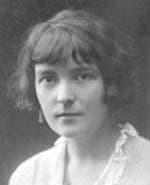Katherine Mansfield
Critique • Works

Born
Wellington, New Zealand, 1888
Died
Fontainebleau, France, 1923
Nationality
British (New Zealander)
Publications
Stories, story collections
Writing languages
English
Literature
• The Garden Party and Other Stories (1922)
Stories
• "Prelude" (1918)
• "The Daughters of the Late Colonel" (1921)
• "The Fly" (1922)
• "The Doll's House" (1922)
• "The Garden Party" (1922)
Story Collections
• The Garden Party and Other Stories (1922)
Australasian Literature
• The Garden Party and Other Stories (1922)
Living and dying in the physical world
Think Virginia Woolf, but with bodies attached to those ever-so-sensitive minds.
That gives you one idea of Katherine Mansfield's writing. Her stories share the fine perception and sensibility of Woolf's novels but her characters are not separate from the physical world. They are engaged in it.
As was Mansfield herself. She was known as quite the female libertine for her time. Travelling around. Sleeping around (with both sexes). Thinking around. Experimenting around. Nothing that Woolf and her Bloomsbury crowd didn't indulge in, mind you, but without their well-bred manners and cover of intellectualism. No wonder Woolf considered Mansfield cheap and whorish, while Mansfield found the slightly older author a prig. (They did seem to have enjoyed discussing writing with each other though. There is even a book available on their intense literary relationship: Katherine Mansfield and Virginia Woolf: A Public of Two.)
The difference in Mansfield's personality perhaps translates in her writing into a greater grounding in the everyday concerns of ordinary people—people with flesh and blood, not just theoretical entities.
Modernist influencer
This may be a vast simplification. We have very little of Mansfield's work to compare, a few collections of short stories published in just over a decade. Mansfield died young from tuberculosis she is suspected to have contracted from D.H. Lawrence. (She is also thought to have been the model for the devilishly uninhibited Gudrun in Lawrence's novels The Rainbow and Women in Love.)
Yet her work is regarded as having greatly influenced short-story writing right up to the present. Along with Joyce (in Dubliners) and several other writers of her time including Lawrence and Woolf, she was an originator of the modernist style, eschewing straightforward narrative to build up each story through the accumulation of finely observed, seemingly inconsequential moments. You may or may not appreciate this transformation of writing (or the later post-modernist, further fragmentation of plot and sense), but you have to accept that almost every serious writer today adopts this approach to some extent. Even writers of popular genres and escapist literature use some of the techniques developed by these writers. Not to do so would make their stories seem too old-fashioned or corny.
The locale's of Mansfield's stories are divided among New Zealand where she was born and raised, England where she finished her education, and Europe where she lived the last half of her short life. The early ones were written for literary magazines to which she contributed regularly. From 1912 she was associated with Rhythm, a modernist publication edited by John Middleton Murry who became her second husband in 1918 and her champion after her death. (Her first marriage, which lasted effectively only a day, was research for a story to see what it felt like, she said.)
Only three collections of her stories were published during her lifetime. In a German Pension came out in 1911 after her experience of pregnancy and losing the child in Bavaria. A short story "Prelude", often considered her best, was published by Woolf's Hogarth Press as a book in 1918 and appeared again in the collection Bliss and Other Stories in 1920. As she was dying of TB, she rushed to complete stories for her most influential collection The Garden Party and Other Stories in 1922.
Two more books of stories, The Dove's Nest (1923) and Something Childish (1924) were published posthumously. Stories of Katherine Mansfield, a best-of selection, appeared in 1930. Collected Stories was published in 1945. Anthologies of her letters, journals and reviews have also been produced since her death.
— Eric
Critique • Works

